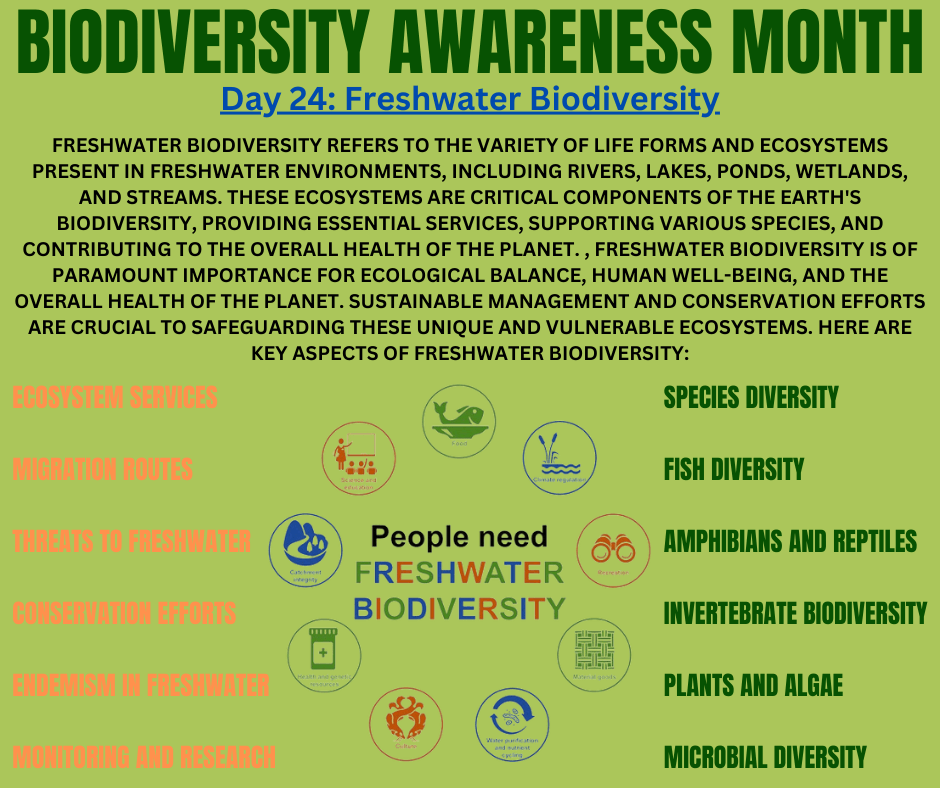Biodiversity month day 24: Freshwater Biodiversity
The St. Maarten Hospitality & Trade Association supports the March Biodiversity awareness month organized by the Nature Foundation in an effort to help protect St. Maartens nature and biodiversity. Todays topic: Freshwater Biodiversity
Freshwater biodiversity refers to the variety of life forms and ecosystems present in freshwater environments, including rivers, lakes, ponds, wetlands, and streams. These ecosystems are critical components of the Earth’s biodiversity, providing essential services, supporting various species, and contributing to the overall health of the planet. Here are key aspects of freshwater biodiversity:
1. Species Diversity: Freshwater ecosystems harbor a diverse range of species, including fish, amphibians, reptiles, invertebrates, and a variety of plants. The unique environmental conditions of freshwater habitats give rise to specialized adaptations in the organisms that inhabit them.
2. Fish Diversity: Freshwater environments are home to a vast array of fish species, both migratory and non-migratory. Fish play crucial roles in freshwater ecosystems, contributing to nutrient cycling, controlling invertebrate populations, and serving as a vital food source for many other species.
3. Amphibians and Reptiles: Freshwater habitats, such as ponds and wetlands, provide important breeding and feeding grounds for amphibians and reptiles. Frogs, salamanders, turtles, and snakes are among the species that depend on freshwater ecosystems during various stages of their life cycles.
4. Invertebrate Biodiversity: Invertebrates, including insects, crustaceans, mollusks, and worms, are abundant in freshwater environments. They contribute to nutrient cycling, serve as food for other species, and play essential roles in maintaining ecosystem balance.
5. Plants and Algae: Aquatic plants and algae are critical components of freshwater ecosystems. They contribute to oxygen production, provide habitats for various organisms, and help stabilize the substrate. Macrophytes, such as water lilies and submerged vegetation, are common in freshwater habitats.
6. Microbial Diversity: Microorganisms, including bacteria, fungi, and protists, contribute to the microbial diversity in freshwater environments. They play crucial roles in nutrient cycling, decomposition, and maintaining water quality.
7. Ecosystem Services: Freshwater ecosystems provide vital ecosystem services, including water purification, flood regulation, groundwater recharge, and support for agriculture and human communities. Biodiversity is essential for the resilience and functionality of these services.
8. Migration Routes: Many freshwater species, particularly fish, undertake migration between freshwater and marine environments. Migratory routes are important for breeding, feeding, and completing life cycles. Examples include salmon and eels.
9. Threats to Freshwater Biodiversity: Freshwater biodiversity faces numerous threats, including habitat destruction, pollution (e.g., nutrient runoff, chemical contaminants), over-extraction of water, climate change, invasive species, and alterations to natural flow regimes. These threats can lead to declines in species abundance and diversity.
10. Conservation Efforts: Conservation initiatives focus on preserving and restoring freshwater biodiversity. Strategies include the establishment of protected areas, restoration of degraded habitats, sustainable water management practices, and efforts to mitigate the impact of invasive species.
11. Riparian Zones: The areas along the banks of rivers and lakes, known as riparian zones, are crucial for maintaining freshwater biodiversity. These zones provide habitat, support nutrient cycling, and help regulate water temperature.
12. Endemism in Freshwater Environments: Some freshwater species are endemic, meaning they are found only in specific freshwater habitats. Endemic species are often vulnerable to habitat changes and environmental disturbances.
13. Monitoring and Research: Ongoing monitoring and scientific research are essential for understanding the status of freshwater biodiversity, identifying key threats, and developing effective conservation strategies.
In summary, freshwater biodiversity is of paramount importance for ecological balance, human well-being, and the overall health of the planet. Sustainable management and conservation efforts are crucial to safeguarding these unique and vulnerable ecosystems.
Back to the Visit St Maarten Main page

